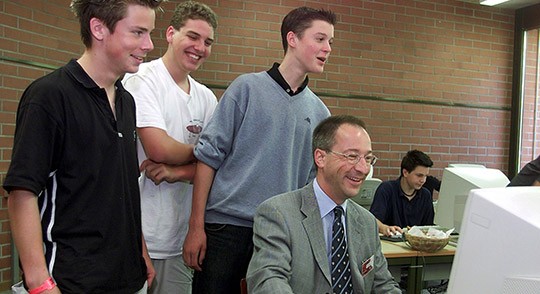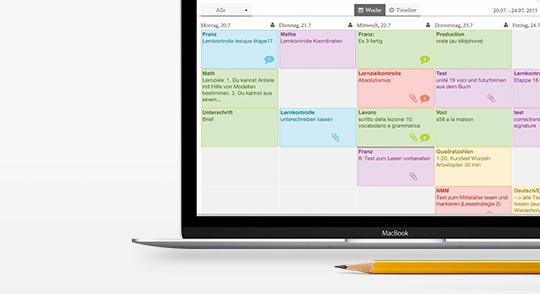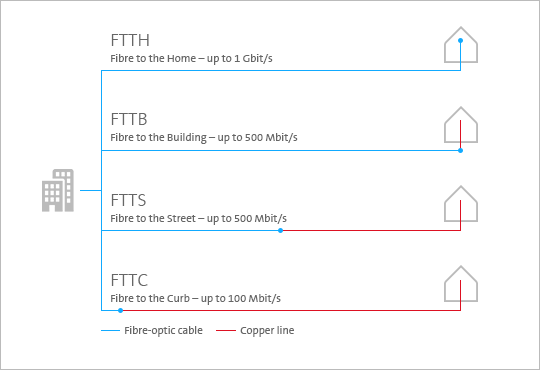
15 years of "Internet for Schools"
From Internet access to key learning technology
Starting 2002 Swisscom has been providing schools nationwide with Internet access. Internet has long become part of daily life, and that includes schools. Yet as well as often revolutionising classroom life in Swiss schools, digitisation is also a challenge for the entire education system. Swisscom’s "Internet for Schools" programme also aims to offer an important contribution to efficient use of ICT in education in the future.
Roger Baur, 23 May 2017
Launched in 2002, "Hello Class" offered Swiss schools free Internet access. And not just free, but also secure: on one hand secured against cyber criminality, and on the other, filtered to protect children from inappropriate content. Filtering not only covers straightforward website blocking, but also scanning of regular Internet addresses. If inappropriate images or videos are posted unexpectedly, they are also filtered out.

Swisscom launched its "Internet for Schools" programme with free Internet access for all Swiss schools in 2002. © Keystone
Classroom revolution
In the beginning, many schools offered IT as a subject in its own right. Teaching often took place in a separate computer room, aimed at familiarising pupils with computers and the Internet. This changed dramatically over the next few years as the Internet became a mass medium with many children already being well-grounded in IT and the Internet when they started school. So nowadays it is customary to include IT as part of subject teaching. A growing number of schools are equipped with one or even several devices in classroom for pupils to research subjects or work on projects.
Digitising teaching
Schools are now poised on the threshold or already in the midst of the next major step: pupils will be issued with their own tablet or notebook on which they will complete most of their school work ("one to one"). An increasing number of teaching aids are now only available as an application – such as the revised French teaching materials of the Passepartout cantons as of summer 2017.The benefits of these aids for schools are obvious: they can identify and work on personal strengths and weaknesses more effectively.
Digitising communication
So far most schools communicate with pupils and parents by analogue methods: by letter, chain calls and telephone messages. The reason for this is the absence of a standardised system. Although Whatsapp is popular, not all parents use this messaging service. Many parents doubt the security of e-mails. Most task and project planning is also analogue: the blackboard or homework book still hold sway in many places – in this case also due to a lack of alternatives.

Swisscom’s "Helloclass" digital class register.
Solutions like the "Hello Class" application pool these demands: they ease communication between parents, pupils, teachers and school administrations. They permit communication in groups of pupils, classes, entire schools or at a personal level.
Classroom videoconferencing
The idea of letting children hospitalised for extended periods take part in schooling through Skype came from the hospitals. A trial in cooperation with Inselspital Bern showed it was easy to put into practice.

Skype unlocks new teaching possibilities. © Keystone
In many countries – like the USA or Singapore – videoconferencing is also used in schools to let experts join in lessons: an author, curator, doctor, scientist, career advisor, trainee – all these external sources can enhance the information provided by teachers with practical examples and enter into a dialogue with pupils. There are fewer hurdles to overcome, much less time involved and no costs. All the experts need is a smartphone with camera; a new videoconferencing solution supports classroom presentation. Swisscom offers this for free as part of "Internet for Schools".
More bandwidth for schools
Increasing use means a steep rise in schools’ bandwidth needs. If one, or even several classes, are online at the same time, the customary Internet speeds of 6 Mbit/s so far provided by "Internet for Schools" will no longer suffice.

Various forms of access via fibre-optic technology.
Swisscom is now going to supply every school with 500 Mbit/s or the maximum available local bandwidth for free. Where there is fibre-optic technology, this can be as high as 1 Gbit/s. However, even in schools not (yet) connected to fibre optics, 500 Mbit/s can be achieved on conventional copper lines with vectoring or G.fast. Today, more than 3.6 million lines benefit from ultra-fast broadband. By 2021 all Swiss communities will have access to fibre-optic technology. In the past 15 years Swisscom has invested an amount around half a billion francs in Swiss schools and will continue to promote digitisation in education in the future.